|
Calcium (Ca) is usually the dominant basic cation
in soils, and only in acid soils with
low CEC is the level of
Ca likely to be so low that it limits plant growth. Strongly acid soils tend to
be high in exchangeable Al, and the toxic effects of Al on root growth may
exacerbate the symptoms of Ca deficiency.
High levels of K and Mg may reduce Ca uptake, and therefore overuse of
fertilisers containing these nutrients may lead to Ca deficiency.
The primary symptom of Ca deficiency is the development of necrotic
tissue on young leaves. The necrosis usually begins along the lateral margins
, and extends inward mainly in interveinal
tissue. Necrotic tissue is mid to dark brown and brittle. Necrosis is not
usually preceded by localised chlorosis,
although the leaves may be uniformly paler than normal. The symptom is first
seen on young expanding leaves, two or three leaves below the tip, but as the
disorder intensifies, newly formed leaves are affected, and finally the apex may
die.
Necrotic leaves may be prematurely shed. In some cultivars,
leaf drop is spectacular, leaving some length of bare stem below the tip. Other
cultivars may show little abscission,
retaining completely dry leaves on the stem.
A second symptom may develop on mature leaves, which is
apparently unrelated to the necrosis of young leaves. Necrotic spots appear,
which are either clustered along the main veins from the petiole attachment
point to about half-way to the margin, or scattered uniformly across the interveinal areas. They are roughly circular with abrupt, irregular edges, and
do not seem to accelerate leaf senescence.
The necrotic tissue in this case is mid brown, and is not brittle. These
symptoms have been reported from two separate studies (Bolle-Jones
and Ismunadji,1963;> O’Sullivan, et al.,1997) in which they were
observed in three of five cultivars, from diverse genetic origins.
Calcium deficiency
inhibits root growth, and in severe cases
root tips may die back. Solution concentrations of 13 µM Ca or below inhibit
the growth of roots on sweetpotato cuttings (Ila'ava, 1997).
Calcium-deficient plants may produce soft, very small and
misshapen storage roots depending on the varieties used. Some varieties
may not produce storage roots at all.
Boron deficiency may also cause death of the shoot tip.
However, necrosis on expanding leaves is uncommon in B deficiency; rather the
young leaves become thickened, puckered and brittle, and are often chlorotic.
A critical Ca concentration of 0.76% of dry weight in the 7th
to 9th youngest leaf blades was estimated in solution culture studies using cv.
Wanmun. In healthy plants, concentrations were generally between 0.9 and 1.2%
Ca. Calcium concentration is dependent on the actual age of the leaves sampled,
as Ca accumulates in the leaf over time. A caution is therefore given against
interpreting the concentration in leaf samples from other parts of the vine than
that for which the critical concentration is specified. Other factors such as
temperature may influence the actual age of the leaves selected, adding to the
difficulty of interpreting leaf analyses for Ca status.
Attempts to measure plant-available Ca in the soil are
generally unreliable, since the availability is dependent on a number of
factors. Exchangeable Ca levels less than 0.2 cmol(+)/kg soil indicate that Ca
deficiency is likely. Very high availability of K (through heavy K
fertilisation) or Na (sodic soils) may cause Ca to be deficient to plants even
though the exchangeable Ca levels may be in what would normally be considered an
adequate range.
Cultural control
Addition of lime (40% Ca). It has the dual effect of
providing Ca and raising the soil pH. Lime is poorly soluble, and consequently
has low mobility in the soil, so it should be broadcast and incorporated
thoroughly into the soil before planting the crop.
Addition of gypsum (22% Ca). It may be used if Ca
deficiency is not associated with soil acidity. It is usually also
incorporated into the soil, although it is more soluble than lime.
Application of single and triple superphosphate (23% and 16% Ca
respectively). These may also be suitable sources where both P and
Ca are in short supply.
Applications of Ca may intensify
deficiencies of Mg or K. It may be necessary to add these nutrients in
conjunction with Ca, so that a suitable cation balance is maintained.
Bolle-Jones,
E.W. and Ismunadji, M. 1963. Mineral deficiency symptoms of the sweet potato.
Empire Journal of Experimental Agriculture 31, 60-64.
Clark, C. A. and Moyer, J.W. 1988. Compendium of sweet potato
diseases. APS Press. 74 p.
Ila’ava,
V.P. 1997. Effects of soil acidity factors on the growth of sweet potato
cultivars. Ph.D. thesis, The University of Queensland, Australia.
Landon,
R.J. 1991) (ed.) Booker tropical soil manual: a handbook for soil survey and
agricultural land evaluation in the tropics and subtropics. Booker Tate Ltd;
Longman, London.
O’Sullivan,
J.N., Asher, C.J. and Blamey, F.P.C. 1997. Nutrient Disorders of Sweet Potato.
ACIAR Monograph No. 48, Australian Centre for International Agricultural
Research, Canberra, 136 p.
Contributed
by:
Jane O'Sullivan
|
Characteristics
and occurrence
Symptoms
Confusion
with other symptoms
Diagnostic
tests
Management
References
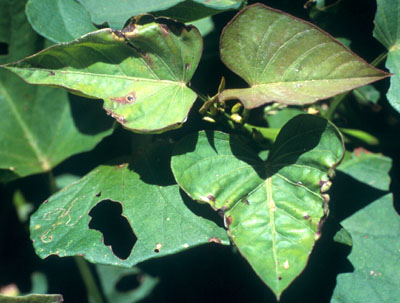
Marginal necrosis develops characteristically at the lateral margins (J. O'Sullivan).
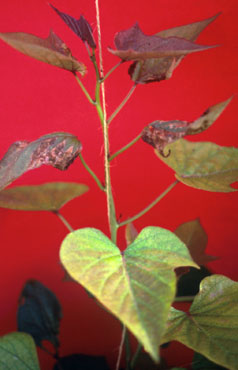
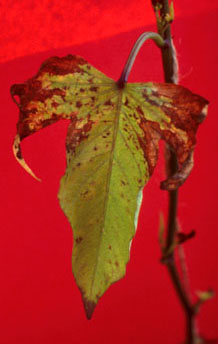
Typical development of necrosis on expanding leaves below the tip.
Leaves are often shed as necrosis proceeds (J. O'Sullivan).
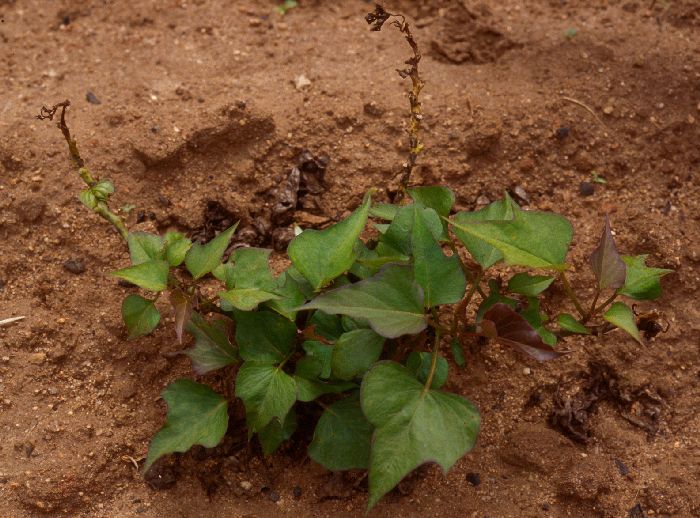
Severe Ca deficiency has caused tip death and shedding of young
leaves (J. O'Sullivan).
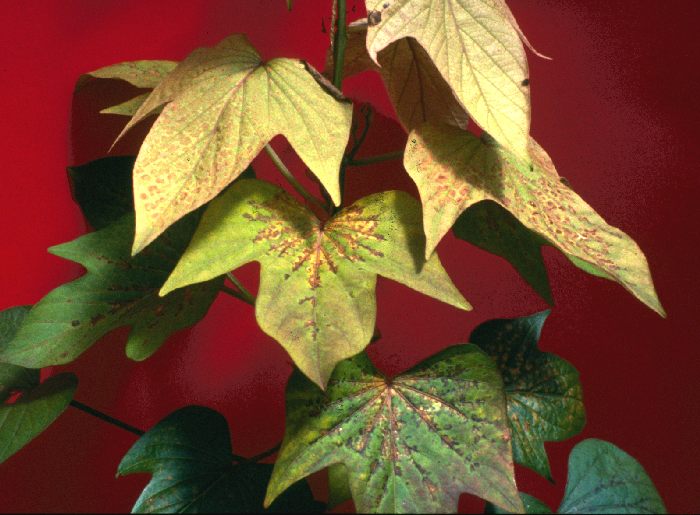
Mature leaves may develop brown spots, either interveinally or
concentrated near veins in the central part of the leaf (J. O'Sullivan).
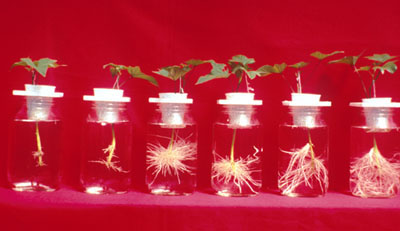
Rooting
of sweetpotato in nutrient solution with 4, 13, 41, 144, 397 and 1328 mM
calcium (V. Ila'ava). |

